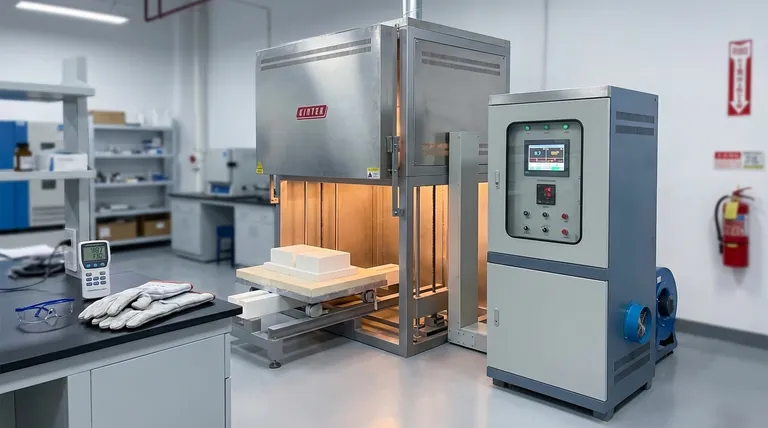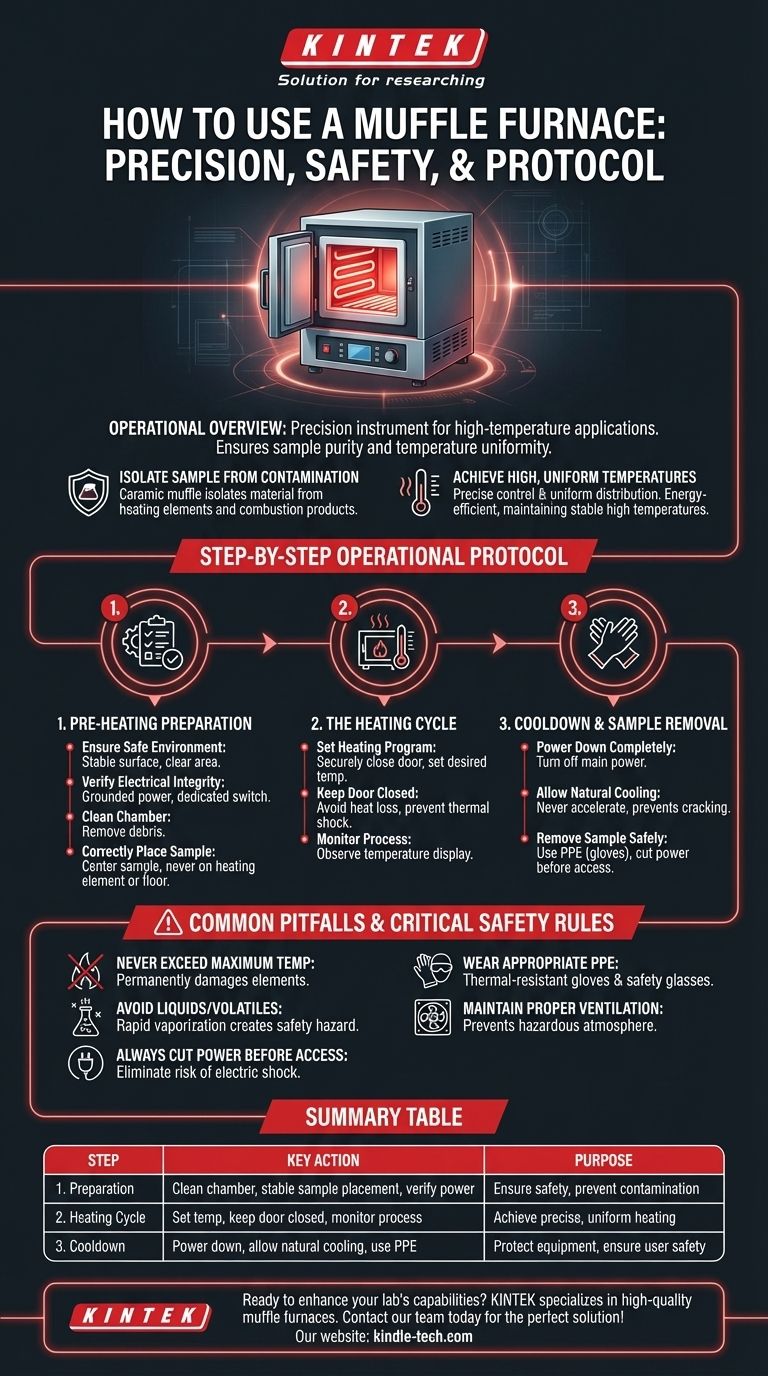To operate a muffle furnace, you must first ensure the power supply is correctly grounded and the furnace chamber is clean. Place your sample in the center of the chamber, set the required temperature and heating time, and keep the door closed during operation. After the cycle, turn off the power and allow the furnace to cool completely to a safe temperature before opening the door and removing the sample with protective gloves.
Using a muffle furnace is a systematic process that goes beyond simply setting a temperature. True success and safety depend on diligent preparation before heating, constant monitoring during the cycle, and a patient, safety-focused approach during cooldown.

The Purpose of a Muffle Furnace
A muffle furnace is not just a simple oven; it's a precision instrument designed for high-temperature applications where sample purity and temperature uniformity are critical.
Isolate the Sample from Contamination
The core component is the "muffle," a chamber typically made of refractory ceramic. This chamber isolates the material being heated from the heating elements and any potential contaminants from combustion.
This ensures the sample is heated only by thermal radiation, resulting in a clean process essential for laboratory ashing, materials research, and heat-treating sensitive components.
Achieve High, Uniform Temperatures
These furnaces are engineered for precise temperature control and uniform heat distribution. The refractory lining prevents heat loss, making them energy-efficient and capable of maintaining stable, high temperatures for extended periods.
Step-by-Step Operational Protocol
Following a strict protocol is essential for both safety and the quality of your results. The process can be broken down into three distinct phases.
Phase 1: Pre-Heating Preparation
This is the most critical phase for preventing accidents and ensuring a successful run.
- Ensure a Safe Environment: Place the furnace on a stable, flat surface. Keep the area around it clear of any flammable or combustible materials.
- Verify Electrical Integrity: Confirm the furnace is connected to a properly grounded power supply. A dedicated power switch should be installed for emergency shut-offs.
- Prepare the Chamber: The muffle chamber must be completely clean and free of debris from previous runs, which could contaminate your sample.
- Correctly Place Your Sample: Place the sample in the middle of the furnace, ensuring it is stable. Never place a sample directly on the heating element or the furnace floor, as this creates a fire risk and can damage the equipment.
Phase 2: The Heating Cycle
During this phase, monitoring and patience are key.
- Set the Heating Program: After securely closing the door, set your desired temperature. Many controllers have indicator lights: a green light often signifies the furnace is heating up, while a red light indicates it has reached and is maintaining the set temperature.
- Keep the Door Closed: Do not open the furnace door during operation. This prevents significant heat loss and avoids introducing cold air, which can cause thermal shock and damage both the furnace and your sample.
- Monitor the Process: Observe the temperature display to ensure it does not exceed the furnace's maximum rated temperature.
Phase 3: Cooldown and Sample Removal
Rushing this final phase is a common and dangerous mistake.
- Power Down Completely: After the heating cycle is complete, turn off the main power supply to the furnace.
- Allow for Natural Cooling: Let the furnace cool down naturally. Never attempt to accelerate cooling by opening the door or introducing cool air, as this can crack the refractory materials.
- Remove the Sample Safely: Once the furnace has cooled to a safe temperature, put on heat-resistant gloves. It is a critical best practice to cut the power supply entirely before reaching into the chamber to prevent any risk of electric shock.
Common Pitfalls and Critical Safety Rules
Mishandling a muffle furnace can lead to equipment damage, ruined samples, or serious injury. Adhering to these rules is non-negotiable.
Never Exceed Maximum Temperature
Operating the furnace above its specified temperature limit will permanently damage the heating elements and refractory insulation.
Avoid Introducing Liquids or Volatiles
Never place samples containing water, oils, or other liquids into a hot furnace. The rapid vaporization can cause a small explosion, damaging the furnace and creating a severe safety hazard.
Always Cut Power Before Accessing the Chamber
Even after the heating cycle, the furnace remains an electrical appliance. Always turn off the power at the main switch before loading or unloading samples to eliminate the risk of electric shock.
Wear Appropriate Personal Protective Equipment (PPE)
Always wear thermal-resistant gloves and safety glasses when handling hot samples or working near the furnace.
Maintain Proper Ventilation
Ensure the room has adequate ventilation, as some processes can release harmful gases. This prevents the accumulation of a hazardous atmosphere.
Making the Right Choice for Your Goal
Your approach should be dictated by your primary objective for using the furnace.
- If your primary focus is analytical purity and repeatable results: Prioritize a meticulously clean chamber and precise, stable placement of your sample in the center of the muffle.
- If your primary focus is operational safety and equipment longevity: Make the power-off-before-accessing rule an unbreakable habit and always allow for a full, natural cooldown cycle.
By treating the muffle furnace as a precision instrument and adhering to a strict safety protocol, you ensure both reliable results and a secure working environment.
Summary Table:
| Step | Key Action | Purpose |
|---|---|---|
| 1. Preparation | Clean chamber, stable sample placement, verify power | Ensure safety and prevent contamination |
| 2. Heating Cycle | Set temperature, keep door closed, monitor process | Achieve precise, uniform heating |
| 3. Cooldown | Power down, allow natural cooling, use PPE | Protect equipment and ensure user safety |
Ready to enhance your lab's capabilities with precision heating? KINTEK specializes in high-quality muffle furnaces and lab equipment designed for reliability and safety. Whether you're in materials research, ashing, or heat treatment, our experts can help you find the perfect solution for your specific needs. Contact our team today to discuss how we can support your laboratory's success!
Visual Guide

Related Products
- Laboratory Muffle Oven Furnace Bottom Lifting Muffle Furnace
- 1400℃ Muffle Oven Furnace for Laboratory
- 1800℃ Muffle Oven Furnace for Laboratory
- 1700℃ Muffle Oven Furnace for Laboratory
- 1400℃ Laboratory Quartz Tube Furnace with Alumina Tube Tubular Furnace
People Also Ask
- What affects the melting point of a substance? Uncover the Key Factors & Forces
- At what temperature is it safe to open a muffle furnace? A Guide to Preventing Injury and Equipment Damage
- What hazard is involved when using a furnace? Protect Your Home from the Silent Killer
- What is the difference between a crucible and a furnace? Understanding the Heat Source and Container Partnership
- Why do we need to use properly some of the laboratory apparatus in the laboratory? The Foundation of Safe and Accurate Science



















